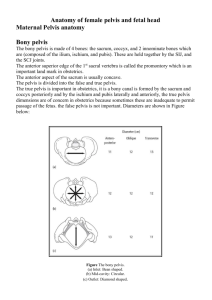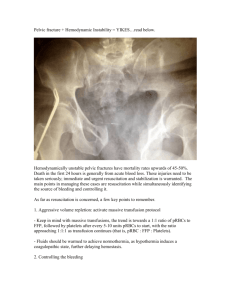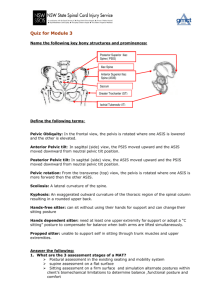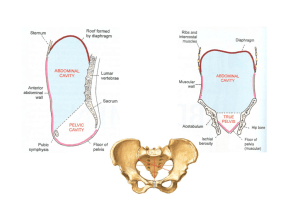The difference between the male and female pelvis
advertisement
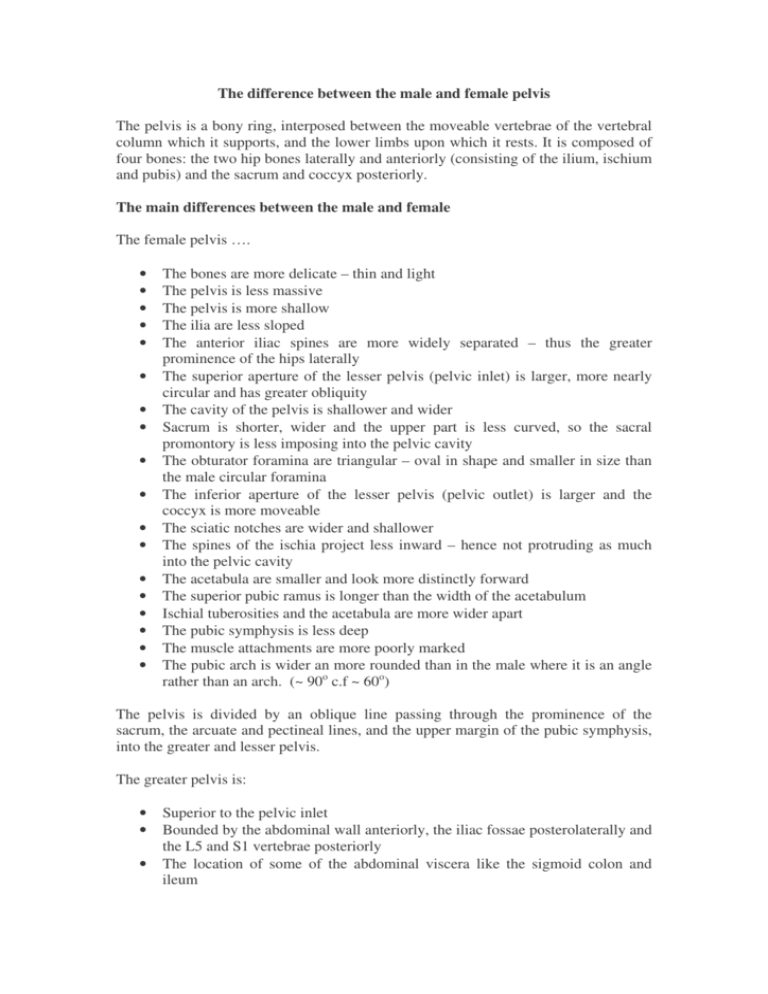
The difference between the male and female pelvis The pelvis is a bony ring, interposed between the moveable vertebrae of the vertebral column which it supports, and the lower limbs upon which it rests. It is composed of four bones: the two hip bones laterally and anteriorly (consisting of the ilium, ischium and pubis) and the sacrum and coccyx posteriorly. The main differences between the male and female The female pelvis …. • • • • • • • • • • • • • • • • • • The bones are more delicate – thin and light The pelvis is less massive The pelvis is more shallow The ilia are less sloped The anterior iliac spines are more widely separated – thus the greater prominence of the hips laterally The superior aperture of the lesser pelvis (pelvic inlet) is larger, more nearly circular and has greater obliquity The cavity of the pelvis is shallower and wider Sacrum is shorter, wider and the upper part is less curved, so the sacral promontory is less imposing into the pelvic cavity The obturator foramina are triangular – oval in shape and smaller in size than the male circular foramina The inferior aperture of the lesser pelvis (pelvic outlet) is larger and the coccyx is more moveable The sciatic notches are wider and shallower The spines of the ischia project less inward – hence not protruding as much into the pelvic cavity The acetabula are smaller and look more distinctly forward The superior pubic ramus is longer than the width of the acetabulum Ischial tuberosities and the acetabula are more wider apart The pubic symphysis is less deep The muscle attachments are more poorly marked The pubic arch is wider an more rounded than in the male where it is an angle rather than an arch. (~ 90o c.f ~ 60o) The pelvis is divided by an oblique line passing through the prominence of the sacrum, the arcuate and pectineal lines, and the upper margin of the pubic symphysis, into the greater and lesser pelvis. The greater pelvis is: • • • Superior to the pelvic inlet Bounded by the abdominal wall anteriorly, the iliac fossae posterolaterally and the L5 and S1 vertebrae posteriorly The location of some of the abdominal viscera like the sigmoid colon and ileum • It supports the intestines and transmits some of their weight to the anterior wall of the abdomen. The lesser pelvis is: • • • • • • Between the pelvic inlet and outlet Known as the true pelvic cavity Bounded by the pelvic surfaces of the hip bones, sacrum and coccyx Limited inferiorly by the musculofascial pelvic diaphragm The location of the pelvic viscera – the urinary bladder and reproductive organs such as the uterus and ovaries Of major obstetrical and gynaecological significance Pelvic inlet The size and shape of the pelvic inlet is important because it is through this opening that the fetal head enters the lesser pelvis during labour. The size of the lesser pelvis is particularly important in obstetrics because it is the bony pelvic canal through which the fetus passes during vaginal birth. To determine the capacity of the female pelvis for childbearing, the diameters of the lesser pelvis are noted radiologically or during a pelvic examination. The pelvic inlet is variable in contour. The shape can be affected by sexual, racial and nutritional differences in the population. It is heart shaped in males and some females, although in most females the opening is larger and is more rounded or oval in contour. The periphery of the pelvic inlet is formed by the pelvic brim which is indicated by the linea terminalis. This is an oblique ridge on the internal surface of the ilium (also known as the arcuate line) and is continued onto the superior pubic ramus as the pectineal line. The inlet is completed anteriorly by the pubic crests and posteriorly by the anterior margin of the base of the sacrum and the sacrovertebral angle (sacral promontory). The inlet has three principal diameters which can be measured: • The anteroposterior. Extends from the sacral promontory to the pubic symphysis and is measured on average about 110mm in the female • The transverse diameter. Extends across the width from the midpoint of the pelvic brim on one side to the other on the opposite side. About 135mm on average in females • Oblique diameter. From the iliopectineal eminence on one side to the sacroiliac articulation on the opposite. Average measurement is 125mm in female Pelvic outlet The pelvic outlet has a more irregular contour. It is bounded posteriorly by the point of the coccyx, and laterally by the ischial tuberosities. These eminences are separated by three notches: one in front, the pubic arch, formed by the convergence of the inferior rami of the ischium and pubis on either side. The other notches, one on either side, are formed by the sacrum and coccyx behind, the ischium in front, and the ilium above; they are called the sciatic notches; in the natural state they are converted into foramina by the sacrotuberous and sacrospinous ligaments. When the ligaments are in situ, the inferior aperture of the pelvis is lozenge-shaped or diamond shaped, bounded, in front, by the pubic arcuate ligament and the inferior rami of the pubes and ischia; laterally, by the ischial tuberosities; and behind, by the sacrotuberous ligaments and the tip of the coccyx. There are two diameters of the pelvic outlet: • • Anteroposterior diameter. Extends from the tip of the coccyx to the lower part of the pubic symphysis. In the female average diameter is 90 – 115mm. It varies with the length of the coccyx, and is capable of increase or diminution, on account of the mobility of the coccyx. Transverse diameter. Measured between the posterior parts of the ischial tuberosities about 115mm in the female. Types of pelvis There are four main types of pelvis, the prevalence dependent on sex and race. For example the relative frequencies in white females is: • • • • Gynaecoid – round with enlarged transverse diameter – normal female type – 41.4% Android – heart shaped – in a woman may present hazards to normal delivery of a baby – 32.5% Anthropoid – long AP diameter – 23.5% Platypelloid – long transverse diameter – 2.6%





